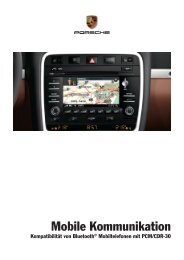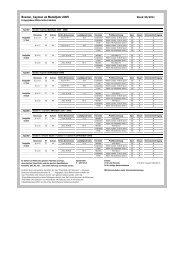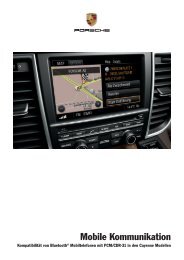You also want an ePaper? Increase the reach of your titles
YUMPU automatically turns print PDFs into web optimized ePapers that Google loves.
ABS Brake System<br />
(Antilock Brake System)<br />
The ABS system represents a major contribution<br />
to the enhancement of active safety in your vehicle.<br />
This system prevents the wheels from locking<br />
in a panic stop on almost all road surfaces.<br />
With the ABS system in your vehicle, the<br />
following areas are enhanced:<br />
Steering, vehicle remains steerable under all<br />
braking forces when ABS is engaged.<br />
Good directional control, no swerving caused<br />
by locking of wheels under braking conditions.<br />
Shorter stopping distance, stopping distances<br />
are usually reduced because controlled braking is<br />
maximized.<br />
Prevention of wheel lock up, no brake- induced<br />
sliding and thus no localized tire wear from emergency<br />
braking.<br />
The crucial advantage of the ABS system over a<br />
conventional brake system is in the area of maintaining<br />
directional control and maneuverability of<br />
the car in emergency situations.<br />
Warning!<br />
The increased control that is provided should<br />
not induce you to take greater risks with your<br />
safety. The limits dictated by the laws of<br />
physics cannot be overcome, even with ABS.<br />
The risk of accidents due to inappropriate<br />
speed cannot be reduced, even by the ABS.<br />
The driver bears the responsibility for all<br />
driving maneuvers.<br />
f Adapt your driving style to the prevailing road<br />
and weather conditions.<br />
f Obey all traffic laws.<br />
Other vehicles not equipped with the ABS<br />
system may not be able to maintain control,<br />
especially on wet or poor road surfaces and<br />
thus may be more likely to impact you from<br />
behind.<br />
f To minimize that risk, use your ABS system to<br />
increase your ability to maneuver to avoid dangerous<br />
situations and not merely to try to stop<br />
in the shortest distance possible.<br />
Operation of the ABS system<br />
A wheel speed sensor is mounted to each of the<br />
four wheels. If wheel lock-up of either of the front<br />
wheels or the rear wheels is sensed during braking,<br />
the brake pressure is adjusted automatically<br />
until the wheel no longer slips.<br />
If braking forces approach the wheel lock-up point<br />
for all wheels (panic braking) the ABS system will<br />
intervene to provide a rapid rythmic braking. The<br />
proper operation of ABS is perceived by the driver<br />
as a pulsating brake pedal in conjunction with audible<br />
noise and perhaps some vibration.<br />
f If you experience these sensations while driving<br />
or a road surface with questionable traction,<br />
reduce vehicle speed appropriate for the<br />
prevailing road conditions.<br />
f If full braking should be necessary, press the<br />
brake pedal all the way down throughout the<br />
entire braking procedure, regardless of the pulsating<br />
pedal. Do not ease up on pressure applied<br />
to the pedal.<br />
The functional readiness of all the main electrical<br />
components of the ABS is checked by an<br />
electronic monitoring system both before and<br />
while you drive.<br />
Operation, Safety 59

















